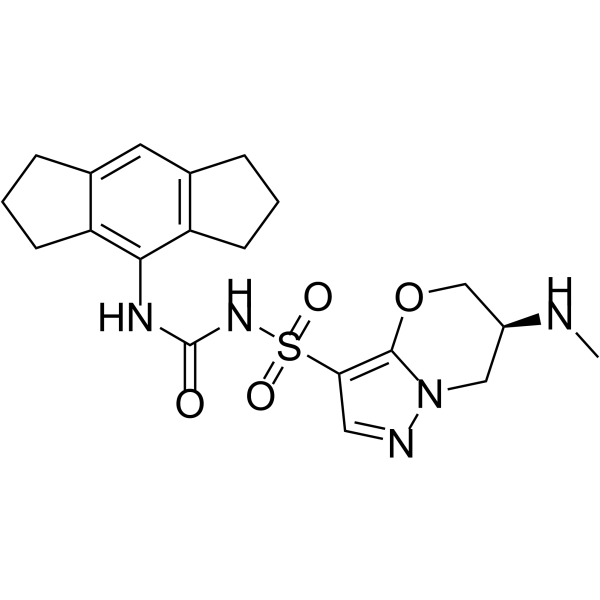Physicochemical Properties
| Molecular Formula | C20H25N5O4S |
| Molecular Weight | 431.50860285759 |
| Exact Mass | 431.162 |
| CAS # | 2238822-07-4 |
| Related CAS # | 2238822-11-0 (R-isomer);2238822-07-4 (S-isomer); |
| PubChem CID | 135242204 |
| Appearance | White to off-white solid powder |
| LogP | 2.2 |
| Hydrogen Bond Donor Count | 3 |
| Hydrogen Bond Acceptor Count | 6 |
| Rotatable Bond Count | 4 |
| Heavy Atom Count | 30 |
| Complexity | 739 |
| Defined Atom Stereocenter Count | 1 |
| SMILES | O1C[C@@H](NC)CN2N=CC(S(NC(NC3=C4C(=CC5CCCC3=5)CCC4)=O)(=O)=O)=C12 |
| InChi Key | NDRARVKETDZHBS-AWEZNQCLSA-N |
| InChi Code | InChI=1S/C20H25N5O4S/c1-21-14-10-25-19(29-11-14)17(9-22-25)30(27,28)24-20(26)23-18-15-6-2-4-12(15)8-13-5-3-7-16(13)18/h8-9,14,21H,2-7,10-11H2,1H3,(H2,23,24,26)/t14-/m0/s1 |
| Chemical Name | 1-(1,2,3,5,6,7-hexahydro-s-indacen-4-yl)-3-[[(6S)-6-(methylamino)-6,7-dihydro-5H-pyrazolo[5,1-b][1,3]oxazin-3-yl]sulfonyl]urea |
| HS Tariff Code | 2934.99.9001 |
| Storage |
Powder-20°C 3 years 4°C 2 years In solvent -80°C 6 months -20°C 1 month |
| Shipping Condition | Room temperature (This product is stable at ambient temperature for a few days during ordinary shipping and time spent in Customs) |
Biological Activity
| ln Vitro | In THP-1 cells, GDC-2394 (20 μM; 30 min) prevents the production of apoptosis associated speck-like protein containing CARD (ASC) specks generated by NLRP3[1]. After the NLRP3 inflammasome is activated, GDC-2394 (1 nM-10 μM; 7 d) suppresses the generation of IL-1β and IL-18 by human macrophages[1]. In addition to inhibiting NLRP3-dependent IL-1β release (IC50=63 nM) and NLRC4-dependent IL-1β release (IC50>20 μM) in mouse bone marrow-derived macrophages (mBMDMs), GDC-2394 (0-20 μM; 30 min) also suppresses caspase-1 activation in THP-1 cells[1]. |
| ln Vivo | In an acute mouse peritonitis model, GDC-2394 (compound 20) (1 mg/kg, 10 mg/kg; po; single dose) suppresses the production of IL-1β[1]. In a functional rat model of gouty arthritis, GDC-2394 (25 mg/kg; once daily for 7 days) is effective in reducing paw edema and pain[1]. GDC-2394's preclinical PK[1]. Mouse Rat Dog Cyno CLp (mL/min/kg) 10.1 1.3 11.7 4.1 Vss (L/kg) 0.72 0.29 0.67 0.18 T1/2 (h) 1.2 4.4 0.99 0.89 %F (1 mg/kg) 80 33 78 53 Instances |
| Animal Protocol |
Animal/Disease Models: Acute mouse peritonitis model[1] Doses: 1 mg/kg and 10 mg/kg Route of Administration: po (oral gavage); 2 h later treated with 1.25 μg LPS (ip) followed by 1 mg monosodium urate crystals (ip) a further 2 h later. Experimental Results: Resulted in a dose-dependent decrease in peritoneal IL-1β concentrations after MSU treatment, and diminished the level of IL-1β by 66.8 and 81.3% at 1 and 10 mg/kg compared with the control. Animal/Disease Models: Functional rat model of gouty arthritis[1] Doses: 25 mg/kg Route of Administration: Interventional injection; one time/day for 7 days Experimental Results: Dramatically inhibited knee swelling after 48 h. |
| References |
[1]. Overcoming Preclinical Safety Obstacles to Discover (S)-N-((1,2,3,5,6,7-Hexahydro-s-indacen-4-yl)carbamoyl)-6-(methylamino)-6,7-dihydro-5H-pyrazolo[5,1-b][1,3]oxazine-3-sulfonamide (GDC-2394): A Potent and Selective NLRP3 Inhibitor. J Med Chem. 2022 Oct 24. [2]. Preparation of hexahydroindacenylcarbamoyldihydropyrazolooxazinesulfonamide derivatives and analogs for use as interleukin-1 activity inhibitors: World Intellectual Property Organization, WO2018136890[P]. 2018-07-26. |
Solubility Data
| Solubility (In Vitro) | DMSO : 50 mg/mL (115.87 mM) |
| Solubility (In Vivo) |
Solubility in Formulation 1: ≥ 2.08 mg/mL (4.82 mM) (saturation unknown) in 10% DMSO + 40% PEG300 + 5% Tween80 + 45% Saline (add these co-solvents sequentially from left to right, and one by one), clear solution. For example, if 1 mL of working solution is to be prepared, you can add 100 μL of 20.8 mg/mL clear DMSO stock solution to 400 μL PEG300 and mix evenly; then add 50 μL Tween-80 to the above solution and mix evenly; then add 450 μL normal saline to adjust the volume to 1 mL. Preparation of saline: Dissolve 0.9 g of sodium chloride in 100 mL ddH₂ O to obtain a clear solution. Solubility in Formulation 2: ≥ 2.08 mg/mL (4.82 mM) (saturation unknown) in 10% DMSO + 90% (20% SBE-β-CD in Saline) (add these co-solvents sequentially from left to right, and one by one), clear solution. For example, if 1 mL of working solution is to be prepared, you can add 100 μL of 20.8 mg/mL clear DMSO stock solution to 900 μL of 20% SBE-β-CD physiological saline solution and mix evenly. Preparation of 20% SBE-β-CD in Saline (4°C,1 week): Dissolve 2 g SBE-β-CD in 10 mL saline to obtain a clear solution. Solubility in Formulation 3: ≥ 2.08 mg/mL (4.82 mM) (saturation unknown) in 10% DMSO + 90% Corn Oil (add these co-solvents sequentially from left to right, and one by one), clear solution. For example, if 1 mL of working solution is to be prepared, you can add 100 μL of 20.8 mg/mL clear DMSO stock solution to 900 μL of corn oil and mix evenly. (Please use freshly prepared in vivo formulations for optimal results.) |
| Preparing Stock Solutions | 1 mg | 5 mg | 10 mg | |
| 1 mM | 2.3174 mL | 11.5872 mL | 23.1744 mL | |
| 5 mM | 0.4635 mL | 2.3174 mL | 4.6349 mL | |
| 10 mM | 0.2317 mL | 1.1587 mL | 2.3174 mL |
